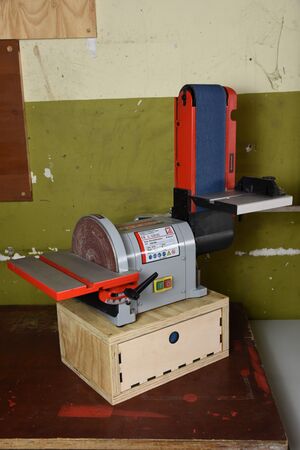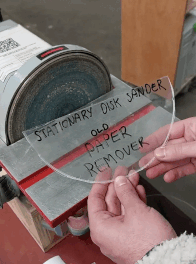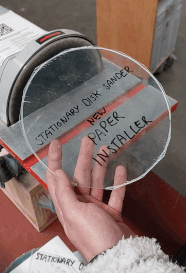Belt and Disc Sander: Difference between revisions
mNo edit summary |
m Infobox links |
||
| (35 intermediate revisions by 7 users not shown) | |||
| Line 1: | Line 1: | ||
{{MachineInfoBox | {{MachineInfoBox | ||
|machine name= | |machine name=Belt and Disc Sander | ||
|german=Band- und Tellerschleifer|image=beltdiscsander.jpg | |german=Band- und Tellerschleifer | ||
|synonyms=| | |image=beltdiscsander.jpg | ||
| | |synonyms=belt and disk sander,<br>belt and disc sanding machine (BDSM);<br>DE: Band- und Tellerschleifer (oder Schleifteller) | ||
| | |material=[[wood]], [[metal]] | ||
| | |used with=[[Sanding Belts|sanding belts]],<br>[[Sanding Discs|sanding discs]] | ||
| | |similar=[[Stationary Belt Sander|stationary belt sander]], [[Disc Sander|disc sander]], [[Belt Grinder|belt grinder]] | ||
| | |extrabox=yes | ||
}} | }} | ||
This type of machine is helpful for all sanding tasks that require a fixed angle. Both sander sides often have adjustable sanding tables and a slot for a miter gauge to guide your workpiece in a defined agle against the sanding disc or belt. | |||
== | == Safety == | ||
Always make sure to adhere to all precautions trained during the [[Stationary Sander Introduction|stationary sander introduction]]. | |||
== Maintenance == | |||
The machine does not require extensive maintenance. Service malfunctions and defects by trained persons only. Regular maintenance: | |||
* After each workshift: Remove chips and sanding dust from the device | |||
* After 10 hours of operation: Check all screw connections and tighten if necessary | |||
Refer to the manual in order learn more about the process to change the grinding belt and the disc. | |||
=== Sandpaper Cleaning === | |||
Sandpaper can be restored a few times before it is used up by briefly sanding a piece of rubber! Instead of proper [https://www.holz-metall.info/shop1/artikel8086.htm cleaning sticks] you can apparently get great results with the sole of an old shoe - any donors? ;-) | |||
<br clear=all> | |||
<!-- NOTE: The following block "imports" content from separate pages - please don't change the code! To edit the actual information, please go back and click "edit" next to the section headline you are interested in :-) --> | |||
{{#ask: | |||
[[MachineType::Belt and Disc Sander]] OR [[MachineType::Stationary Sander]] | |||
|order=descending | |||
|format=embedded | |||
|embedonly=yes | |||
| | |||
| | |||
| | |||
}} | }} | ||
[[Category:Sanders]] | |||
[[Category:Sanding]] | |||
[[Category:Woodworking]] | |||
Latest revision as of 12:24, 11 March 2025
| MachineInfoBox Belt and Disc Sander | |
|---|---|

| |
| Synonyms: | belt and disk sander, belt and disc sanding machine (BDSM); DE: Band- und Tellerschleifer (oder Schleifteller) |
| Material: | wood, metal |
| Used with: | sanding belts, sanding discs |
| Access Requirements: | Stationary Sander Introduction |
| Tutors: | Lukas Pakue Johannes Luzian Utis Sebastian Jakob |
| Similar (More or Less): | stationary belt sander, disc sander, belt grinder |
This type of machine is helpful for all sanding tasks that require a fixed angle. Both sander sides often have adjustable sanding tables and a slot for a miter gauge to guide your workpiece in a defined agle against the sanding disc or belt.
Safety
Always make sure to adhere to all precautions trained during the stationary sander introduction.
Maintenance
The machine does not require extensive maintenance. Service malfunctions and defects by trained persons only. Regular maintenance:
- After each workshift: Remove chips and sanding dust from the device
- After 10 hours of operation: Check all screw connections and tighten if necessary
Refer to the manual in order learn more about the process to change the grinding belt and the disc.
Sandpaper Cleaning
Sandpaper can be restored a few times before it is used up by briefly sanding a piece of rubber! Instead of proper cleaning sticks you can apparently get great results with the sole of an old shoe - any donors? ;-)
Holzmann BT 203-914
| MachineInfoBox Holzmann BT 203-914 | |
|---|---|

| |
| Type: | Belt and Disc Sander |
| Material: | wood, metal |
| Used with: | 914x100 mm sanding belts 203 mm sanding discs (velcro/Klett) |
| Location: | Grinding Table |
| Access Requirements: | Stationary Sander Introduction |
| Status: | Working |
| Manual: | in wooden box below the machine / PDF on manualslib |
| Tutors: | Lukas Pakue Johannes Luzian Utis Sebastian Jakob |
| Similar (More or Less): | belt sander, disc sander |
This machine stands in the metal workshop (next to the bench grinders) on a wooden box containing the manual and the accessories.
It is a combined disc and belt sander with a 203 mm sanding disc and a 914x100 mm belt sander. Both are always simultaneously driven by the 550W motor. Belt speed is 9,5 m/s and disc speed is 2850 rpm.
Features
The machine has the following features
- pivoting aluminium table for disc and belt sander (up to 45°)
- sanding belt unit tiltable from 0-90° (can be used horizontally and vertically)
- mitre fence for precise angle sanding
- suitable for longitudinal and front edges, round and mitre sanding and plane faces
In the factory version, the sanding disk was glued. We modified the machine to accept velcro-backed abrasive discs for much more comfort!
To change discs without disassembling half of the machine, you should slide a separator between the velcro pad and the sanding disc:


Materials
As by the makers specification, the machine is permitted to process wood, and wood-like materials.
Use the disc sander for rough shaping, or to create outside curves on wood. Use the belt sander to sand your wood or other material. Should you use it to process other materials or light metals, such as Aluminium, adhere to the special precautions mentioned in the machine introduction, and make sure that the mounted sanding belt/ disk supports your material.
Proper Use
Always check the following before you start to work with the machine
- All cables and plugs
- Loose screws and connections. Damaged parts have to be replaced immediately, no operation of the machine in the meantime!
- Tight fit of table and safety fence
- The free and centered run of sanding belt and disc
- Attention! To prevent fingers from being squeezed between the band and table, a maximum separation of 3 mm has to be maintained between the table and grinding band. Check that this is the case.
Configure the machine for your use case (table-angles etc).
- The angle stop can be used for angles of up to 45°, to the left or right, by releasing the locking button and adjusting the angle stop to the desired angle.
- The backing plate of the grinding belt has to be adjusted so it almost touches the grinding belt. In order to adjust it, release the two screws holding the plate in the machine rack. Tighten the screws again after you adjusted the plate.
- To remove the plate to perform special jobs (e.g. polishing or contour-grinding), loosen the two attachment screws
When working with the machine, do not apply too much pressure to the sanding abrasive.
As the machine offers no possibility to clamp your material, it is vital that the workpiece maintains stable contact with the worktable at all times!